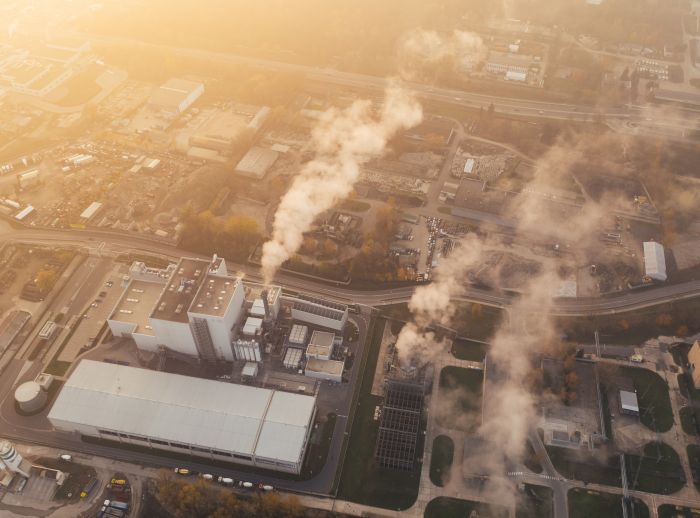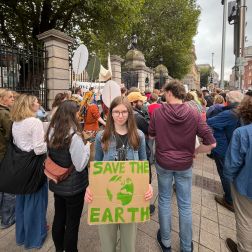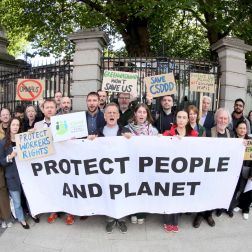- 4 mins read time
- Published: 1st March 2021
More talk, still not enough real action on climate change
By Joanne O’Connor, Content Executive with Oxfam Ireland and MSc in Climate Change student
22 April 2021
For anyone with even a passing interest in the biggest threat facing our planet, this week is big.
Today, US President Joe Biden will host world leaders for the first of a two-day virtual Earth Day Summit, during which countries will be expected to make new commitments on emissions reductions. Ireland, which was not on the original guest list, has since made the cut because of its scaled-up climate targets and support of developing countries with their resilience efforts.
The optimist in me hopes we’re at a turning point. The cynic in me has seen all this before. After all, it seems like only a couple of glaciers ago that we witnessed the fanfare the 2015 Paris Agreement and the countries of the world uniting to address one common problem.
What’s happened since? Well, recent news from the UN makes for depressing reading. It reported that new or updated Nationally Determined Contributions, or NDCs (countries’ efforts to reduce their emissions and adapt to the impacts of climate change) for 75 of the Agreement’s signatories found that the changes in their actual emissions would be small, despite their pledges.
Not small – tiny. The changes made by these countries would result in less than a one percent emissions reduction in 2030 compared to 2010. To meet the 1.5°C temperature goal of the Agreement, they should be around 45 percent lower in 2030. Just a 44 percent shortfall, then. (To clarify, the NDCs in this report account for 30 percent of emissions worldwide. So, not all emissions but the findings are still significant.)

Forgive the cliché but we really are at a crossroads now.
Take it from someone who remembers all the panic about the hole in the ozone layer back in the 1980s. The damage to the layer, which protects us from harmful UV radiation, was caused by chlorofluorocarbons (CFCs) – chemicals used in aerosol cans and fridges. As a result, the threat of skin cancer was never far away, albeit never quite close enough to make us wear sunscreen.
In 1987, world leaders did something quite shocking – they acted. They signed the Montreal Protocol, uniting to reduce the use of CFCs. Just three years later, they agreed that CFCs would be phased out completely by 2000.
And the commitments made in 1987 and 1990 weren’t meaningless – they actually worked. In 2019, NASA reported that the “ozone hole” had shrunk to a record low.
I was naïve enough to think that world leaders would do something similar about global warming. Act, not just talk. Because there’s been a lot of talk – at hearings, conferences and summits. Now, more than 30 years since climate scientist James Hansen told a US congressional hearing that he could say “with 99% confidence” that global temperature rise was due to human activity, politicians are still talking.
Even as President Biden meets with other world leaders over the next two days, greenhouse gas emissions will continue to rise, contributing to the rise in the average global temperature. If they don’t take radical, drastic action now, the consequences will be dire.
Coincidentally, it was British scientist James Lovelock who first noticed high levels of CFCs in the atmosphere in the 1960s. The father of the Gaia Theory, the concept that life on Earth is a self-regulating community of organisms interacting with each other and their surroundings, has a worrying take on where we’re all headed.
In his 2009 book, The Vanishing Face of Gaia, Lovelock writes that ‘global heating’, as he calls it, doesn’t mean linear changes in temperature, but sudden abrupt shifts. These abrupt changes alongside an increasing global population, Lovelock says, will do irreversible damage to large swathes of the planet. Only a few ‘lifeboats for humanity’ would survive, including countries like Ireland, the UK, Japan, Tasmania and New Zealand. Scandinavia will also be spared. Lovelock believes that while we should do what we can to cut emissions, it’s time to think about adaptation.
Others, however, argue that it’s not too late to turn this ship around. One of those people is climate scientist Michael E. Mann, the co-author of the “hockey-stick graph” in 1999, which showed the sharp rise in global temperatures since the industrial age – and the clearest evidence of the link between human emissions and global warming. Mann insists that doom-mongering, which has overtaken denial as a threat and as a tactic, poses a major threat to climate action.
Fatalism, therefore, is not the answer. We just have to take urgent action to protect our planet – and ourselves.
Now, could somebody please talk to the politicians?




